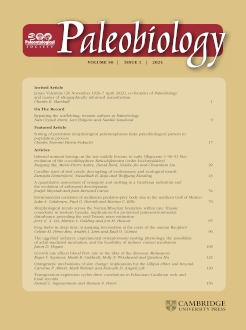Coccolithophores are unicellular algae, with the cell surface covered by calcite scales (coccolith). Coccolithophore size has become progressively smaller from the late Paleogene to the present. The first size reduction (FSR) occurred ∼32 million years ago in the most successful modern lineage, the order Isochrysidales. To decipher the driving mechanism(s) behind the FSR, we conducted a morphologic analysis on the fossils of coccolithophores that lived during the late middle Eocene to early Oligocene (∼40–31 million years ago), using marine sediments from the South Atlantic Ocean. Our data show a strategic divergence between groups of large and small coccolithophores. The group of larger coccolithophores increased in size by ∼4 µm before their extinction, while the size range of the group of smaller coccolithophore contracted. In addition, the central opening on the coccolith decreased in all species from the late Eocene to early Oligocene. We infer that the increased nutrient availability during the Eocene/Oligocene climate transition may be responsible for the morphologic evolution. We hypothesize that larger species with larger central openings on their coccoliths were more dependent on mixotrophy, making them better adapted to the nutrient-poor conditions from the middle to late Eocene. On the other hand, smaller species whose central opening dwindled were better adapted to nutrient-rich conditions during the early Oligocene. Our inference supports the idea that the diversity of trophic strategies among phytoplankton is underestimated.
The first size reduction (FSR) in the Reticulofenestra-Gephyrocapsa-Emiliania (RGE) lineage (order Isochrysidales), which occurred in the early Oligocene (∼32 Ma), is of great significance for understanding the Lilliput effect that has affected coccolithophore communities from the late Eocene to this day. We conducted a morphologic analysis on the coccoliths of Reticulofenestra species that lived during the late middle Eocene to early Oligocene (∼40–31 Ma), using marine sediments from the South Atlantic Ocean. Our data show increasing size and decreasing abundance of the large species during the late Eocene, leading to their disappearance at the FSR, and a concurrent decrease in the size variability of the small- to medium-sized coccoliths whose central opening diameter had become very reduced. Although the cosmopolitan late Paleogene through Neogene size decrease in coccolithophores has been linked to the concomitant long-term decline in global pCO2, we suggest here that the FSR was the result of environmental destabilization caused by the expansion of eutrophic environments following the late Eocene establishment of overturning circulation associated with ice buildup on Antarctica. This study also leads us to propose a hypothetical model that links coccolith morphology of species of the RGE lineage and trophic resources in the upper ocean: the small- to medium-sized, r-selected coccolithophores with smaller coccolith central openings live in nutrient-rich waters where they rely mostly on photosynthesis and little on mixotrophy, whereas the larger, K-selected species with larger coccolith central openings live in oligotrophic waters where they are more dependent on mixotrophy.






